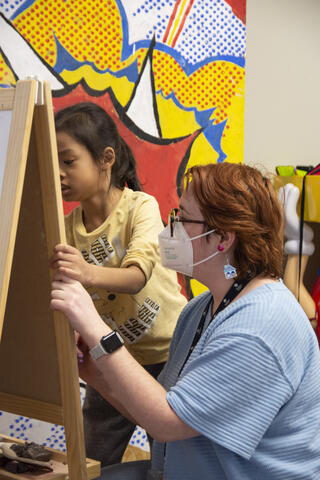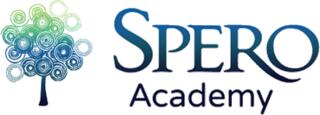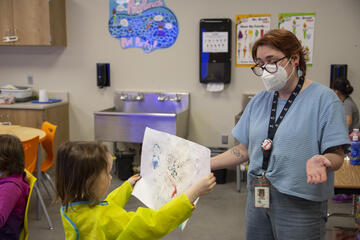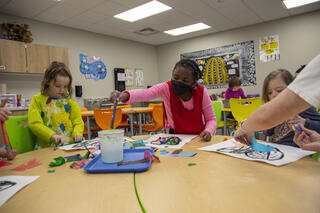
Images by Emma Gottschalk
by Devin Taylor
If you follow us on Social Media, you’ve probably seen the work of some of our student artists. You may have noticed our celebration of Youth Art Month and you may even know a few of the reasons we think Art Education is so important. At Spero Academy, we are always looking for ways to help students engage with core subjects while helping them to grow socially and emotionally. Visual art projects are one strategy that Spero teachers use to accomplish both of these goals.
How does that work, you ask?
It’s widely acknowledged that Art Education improves reading and math skills. There is ample evidence that participation in art promotes the development of analyzing and problem-solving skills. According to a 2002 study reported in USA Today, based on a Meta-analysis performed by the Arts Education Partnership, visual arts “improve content and organization of writing; promote sophisticated reading skills and interpretation of text, reasoning about scientific images and reading readiness.”
Spero teachers often incorporate art into other subjects such as math, science, and reading. We’ve seen the ways that visual art helps students engage with various subject matters, even improving academic performance. These are important benefits to be sure, but we also recognize that art and art education have merits all their own. Art instruction is restorative. It has the power to instill within students a better understanding of the world around them and even help them better understand themselves. For this reason, we were delighted to begin our first school year with an official Art Program. As the end of the year draws to a close, we think it’s about time we heard from Spero’s new (and first ever) full time Art Teacher.
 Meet Tori Rogers
Meet Tori Rogers
Ms. Rogers joined the Spero Academy team in the Summer of 2021, and since then the halls of Spero are alive with the colors and textures of student expression. We asked for a moment of her time to learn more about the art program at Spero. We even got her to talk a little about herself! Here’s what she had to say:
What drew you to art education?
I have always been interested in creating since I have been able to hold a pencil. Art has helped me in so many different ways throughout my own life. I see the value and importance of having a great art education and hope to create passion and appreciation for the arts within future generations.
Can you talk a bit about your own experience with art?
I cannot remember a time when I wasn’t creating art. I started out drawing and painting in my younger years and slowly moved to creating jewelry and little sculptures once I discovered the invention of the hot glue gun. In school, I have worked with so many different mediums and discovered that I love to learn and try different things. Just this past year I have dabbled in stained glass, ceramics, and latch-hook rug making.
How would you describe your first year at Spero?
I would describe my first year at Spero as colorful and exciting!
What are some ways you incorporate student art into the school community?
I love to hang our colorful masterpieces in the halls for all the students and staff to enjoy. Most classes do not work on the same project so this gives students a chance to see what other classes are doing and appreciate the many artistic talents at Spero. When I have the time, I also love making interactive bulletin boards outside of my room. Students are free to add to the board if they have free time in their schedules. I love seeing the work students create outside of art class!
Do you have a favorite medium or one that you particularly love to share with your students?
Personally, I always find myself going back to drawing with pencil and markers. I LOVE working with clay with my students. Starting a clay project is always so exciting with any age level.
Are there any concepts you feel are especially important to incorporate into the art curriculum?
I believe that talking about art and incorporating art history is equally as important as creating art. I try to include as much art history or real world connections to my lessons as possible. Upper-level classes have begun critiquing work made by other artists as well as their own.
What are some teaching strategies you use?
I try to keep my lessons varied as possible, always exploring new ways to create. I also like to include personal choice in projects whenever possible. Letting students create work that is meaningful to them strengthens the bond between themselves and art. This keeps students interested and always looking forward to the next art class.
.JPG?mask=2)
I always try to remind students that we are focusing on progress, not perfection. Every time you work on a project, your artistic skills are being refined and you are learning every step of the way. You may not see the whole picture yet, but if you take a look at what you’ve accomplished so far, you might be impressed with the progress you have made.
Do you have a favorite project to work on with students?
One of my favorite artists to teach about is Yayoi Kusama. You may have seen her giant pumpkin on my wall if you have stepped into the art room. Her work is loud and bold and full of so many fun elements to teach to the students.
Can you share some of your artistic or educational influences?
While studying art education, I fell in love with art history. I love learning about fascinating movements in art that really turned the tide, such as the “Happenings'' movement. Contemporary art is also a huge influence in my own personal work and within the classroom. A few of my favorite contemporary fine artists include Yayoi Kusama, Hattie Stewart, and Ai Weiwei. I also love to support and am inspired by artists with small businesses such as Mexakitsch, Wawe, and KariLeeArt.
What are some words your students would use to describe you?
I would say students would describe me as colorful, passionate, and artistic!
What does the community need to know about art education and its impact on student growth and learning?
A quality art education has a HUGE impact on student growth and learning. Students are able to learn different skills in art class that are transferable to basically any other aspect of their life and education. These skills can really aid a student in their educational and emotional growth. Just a few of these imperative skills include creativity, confidence, problem solving, focus, collaboration, and communication.
So there you have it! Art education is a more-than-welcome, much needed addition to our personalized, adaptive education program. As we continue to grow to meet the needs of more students, we are excited to watch the Art program grow too. We think it’s in pretty good hands!
To learn more about the connection between Art and Literacy, check out this interactive resource from The Arts Education Partnership.


.JPG?mask=32)
.JPG?mask=2)

.JPG?mask=2)
